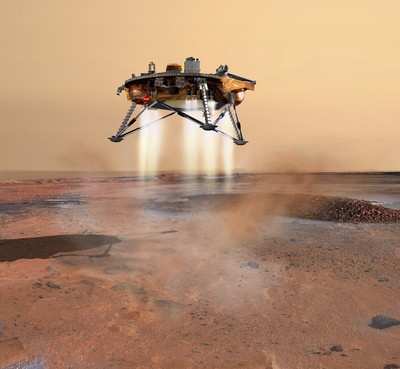NASA Data Shed New Light About Water and Volcanoes on Mars
 Data from NASA's Phoenix Mars
Lander suggest liquid water has interacted with the Martian surface
throughout the planet's history and into modern times. The research
also provides new evidence that volcanic activity has persisted on
the Red Planet into geologically recent times, several million
years ago.
Data from NASA's Phoenix Mars
Lander suggest liquid water has interacted with the Martian surface
throughout the planet's history and into modern times. The research
also provides new evidence that volcanic activity has persisted on
the Red Planet into geologically recent times, several million
years ago.
Although the lander, which arrived on Mars on May 25, 2008, is
no longer operating, NASA scientists continue to analyze data
gathered from that mission. These recent findings are based on data
about the planet's carbon dioxide, which makes up about 95 percent
of the Martian atmosphere. "Atmospheric carbon dioxide is like a
chemical spy," said Paul Niles, a space scientist at NASA's Johnson
Space Center in Houston. "It infiltrates every part of the surface
of Mars and can indicate the presence of water and its
history."
Phoenix precisely measured isotopes of carbon and oxygen in the
carbon dioxide of the Martian atmosphere. Isotopes are variants of
the same element with different atomic weights. Niles is lead
author of a paper about the findings published in Thursday's online
edition of the journal "Science." The paper explains the ratios of
stable isotopes and their implications for the history of Martian
water and volcanoes. "Isotopes can be used as a chemical signature
that can tell us where something came from, and what kinds of
events it has experienced," Niles said.
This chemical signature suggests that liquid water primarily
existed at temperatures near freezing and that hydrothermal systems
similar to Yellowstone's hot springs have been rare throughout the
planet's past. Measurements concerning carbon dioxide showed Mars
is a much more active planet than previously thought. The results
imply Mars has replenished its atmospheric carbon dioxide
relatively recently, and the carbon dioxide has reacted with liquid
water present on the surface.
Measurements were performed by an instrument on Phoenix called
the Evolved Gas Analyzer. The instrument was capable of doing more
accurate analysis of carbon dioxide than similar instruments on
NASA's Viking landers in the 1970s. The Viking Program provided the
only previous Mars isotope data sent back to Earth.

Mars Phoenix Lander/NASA Image
The low gravity and lack of a magnetic field on Mars mean that
as carbon dioxide accumulates in the atmosphere, it will be lost to
space. This process favors loss of a lighter isotope named
carbon-12 compared to carbon-13. If Martian carbon dioxide had
experienced only this process of atmospheric loss without some
additional process replenishing carbon-12, the ratio of carbon-13
to carbon-12 would be much higher than what Phoenix measured. This
suggests the Martian atmosphere recently has been replenished with
carbon dioxide emitted from volcanoes, and volcanism has been an
active process in Mars' recent past. However, a volcanic signature
is not present in the proportions of two other isotopes, oxygen-18
and oxygen-16, found in Martian carbon dioxide. The finding
suggests the carbon dioxide has reacted with liquid water, which
enriched the oxygen in carbon dioxide with the heavier
oxygen-18.
Niles and his team theorize this oxygen isotopic signature
indicates liquid water has been present on the Martian surface
recently enough and abundantly enough to affect the composition of
the current atmosphere. The findings do not reveal specific
locations or dates of liquid water and volcanic vents, but recent
occurrences of those conditions provide the best explanations for
the isotope proportions.
The Phoenix mission was led by principal investigator Peter H.
Smith of the University of Arizona in Tucson, with project
management at NASA's Jet Propulsion Laboratory in Pasadena, Calif.
The University of Arizona provided the lander's thermal and evolved
gas analyzer.
 ANN's Daily Aero-Linx (04.16.24)
ANN's Daily Aero-Linx (04.16.24) Aero-News: Quote of the Day (04.16.24)
Aero-News: Quote of the Day (04.16.24) Airborne 04.10.24: SnF24!, A50 Heritage Reveal, HeliCycle!, Montaer MC-01
Airborne 04.10.24: SnF24!, A50 Heritage Reveal, HeliCycle!, Montaer MC-01 Airborne 04.12.24: SnF24!, G100UL Is Here, Holy Micro, Plane Tags
Airborne 04.12.24: SnF24!, G100UL Is Here, Holy Micro, Plane Tags Airborne-Flight Training 04.17.24: Feds Need Controllers, Spirit Delay, Redbird
Airborne-Flight Training 04.17.24: Feds Need Controllers, Spirit Delay, Redbird




